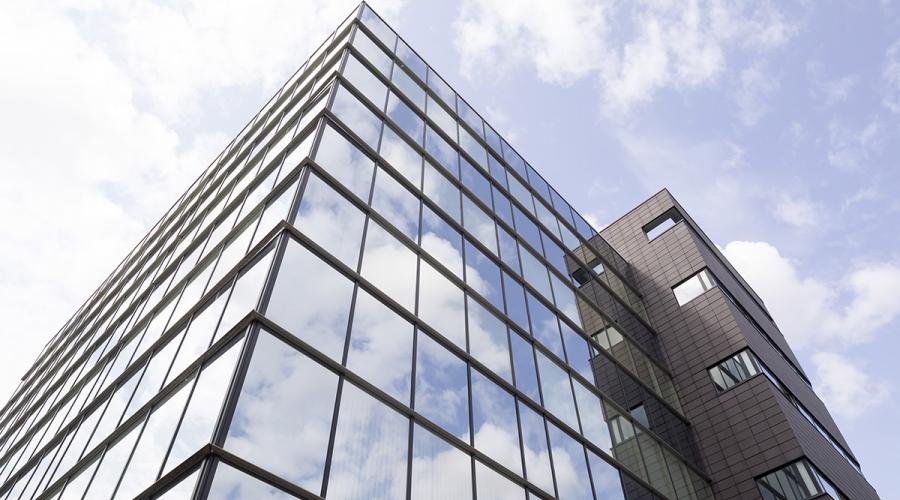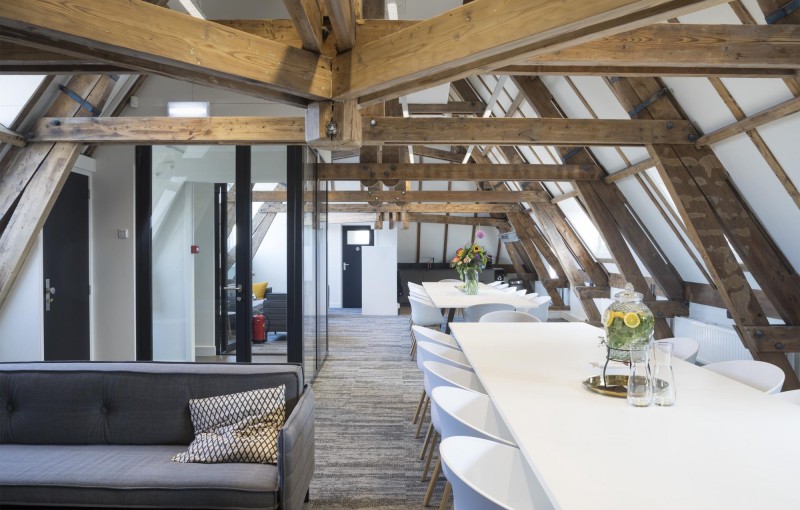
Multi-tenant building or business centre, what suits your company best?

Much has changed in the office market in recent years. In particular, the increase in variety of the offer can be called remarkable. In the past, office buildings were mainly divided into single tenants and multi-tenants. Nowadays, entrepreneurs have more choice, which does not always make it easy. In order to help you make a choice, in this article we will contrast the two most popular options, the collective company building and the business centre. We will take a closer look at these types of offices, the similarities/differences and discuss the advantages and disadvantages.
What is a multi-tenant building?
A multi-tenant building is a building that is divided into several rentable offices or departments to accommodate different businesses. In multi-tenant office buildings, different variations of service levels and shared facilities are possible. In essence, you rent an office and have to provide facilities yourself and no services are offered. Do you need a meeting room and kitchenette? Then it's a matter of arranging these yourself within your office. However, some multi-tenant buildings do have one or more meeting rooms available for tenants. Toilet facilities are usually shared with the other companies on the same floor. So, you arrange most of it yourself.
This also applies to the services. Generally speaking, there are few, if any, services provided in multi-tenant office buildings. There is no reception area to receive customers, you have to collect the post yourself and there is no shared lunch. If you want internet, you can arrange this yourself with a provider. Of course, there are exceptions to the rule. For example, there are a number of multi-tenant buildings that offer internet and lunch. In a business centre, such facilities and services are usually provided.
What is a business centre?
In a business centre there are, just like in a collective business building, several companies housed in one building. A business centre usually has several tenants. The landlord maintains a high service level and tries to relieve the tenants as much as possible. Complete focus on the core business is perhaps the biggest advantage of renting in a business centre. Landlords often create a kind of office concept with an identity and a community all of its own. Examples are Spaces, WeWork and Regus.
The above division between multitenant buildings and business centres has become increasingly blurred in recent years. This is because the collective business centres are offering more and more services.
Similarities between business centres and staff association buildings
There are many similarities between a multitenant building and business centers, but also some differences. This mainly has to do with the service level and the facilities. In the recent past it was mainly smaller companies (up to 5 workplaces) that rented an office unit in a business centre or multitenant building. That has changed nowadays. Larger organisations are increasingly opting for this.
Flexible leases
It is rare for business centres and multitenant buildings to enter into five- or ten-year leases. Most contracts run from a few months to a maximum of a few years. This provides flexibility for both the tenants and the landlord, but naturally also brings risks. For the tenant, for example, the contract may be unintentionally not renewed and the landlord is not sure of the rental income for a long time.
Growing or shrinking within the same office building
Are you renting in a multi-company building or business centre? Then in consultation with the landlord you can often easily expand or contract. Perfect if you are growing quickly but do not want to move house all the time. In that case, for example, the lease already stipulates that the tenant can be moved within the building to make this possible. A tenant who wants to expand then has a so-called 'right of first refusal'. A right of first refusal gives a sitting tenant the right to rent newly vacated office space. Even if another party shows an interest. In such a case, the space can only be leased if the sitting tenant indicates that he is not interested.
Cross-fertilisation between companies
An office building with several entrepreneurs and their businesses offers another great advantage. Landlords often provide places where social interaction is facilitated. Think of a coffee corner or a shared lunch opportunity. Thanks to this interaction, cross-pollination between companies occurs. With collaboration and inspiration as a result. Moreover, there are also regular initiatives to organise fun things together. A joint BBQ, for example.
As mentioned above, both small and larger companies from different and sometimes the same industry sector rent in a business centre or collective business centre. The advantage of this is that young and older companies learn from and inspire each other. The established parties can share their experiences and young entrepreneurs provide new insights, ways of thinking and ideas.
Differences between multitenant buildings and business centres
In collective business buildings, in short, only offices are made available to the tenants. Business centres are much more based on the principle of 'office as a service', where you are provided with all the conveniences you could wish for as a tenant. This is also the reason why the rental prices of a business centre are usually higher than those of a collective business centre. The services that are offered vary widely. The average business centre has at least one reception desk, fully furnished offices, internet and a lunchroom.
Reception
A business centre always has a staffed reception area that welcomes clients and directs them to the right companies/people. The reception desk also serves as a contact point for tenants. They can come here with their questions and remarks about rental matters. Multitenant buildings rarely if ever have a reception desk.
IFRS-16 regulations (lease accounting)
Another difference between multitenant buildings and business centres is the option of renting the office as a service. This came about after the introduction of the new IFRS-16 regulations. These regulations stipulate that all leases must be reported on the balance sheet, so also the lease of your office space. One of the exceptions to this is when the office is leased via a service level agreement. This is easy to realise in a business centre because many of the facilities that need to be included have already been arranged. In a multitenant building this is sometimes possible, but it is more work. It requires good cooperation with the landlord. Would you like to know more? Read our blog: renting office space and IFRS-16.
Fully furnished offices and internet/telephony
As a tenant in a business centre you only need to bring your laptop and you can get to work. The office is delivered furnished. Internet and telephony are already taken care of. These are things that are usually not available in a collective business centre. The tenants have to take care of this themselves.
Lunch at the office
Business centres often have a company restaurant. Sometimes an external caterer is used to provide tenants with a delicious lunch. In multi-tenant buildings this can vary. In one building, each company organizes everything itself, while in other buildings there is a communal lunch.
Where can you find multitenant buildings and business centres?
Most multitenant business buildings and business centres can be found in Amsterdam, Rotterdam, Utrecht and The Hague. In short, the largest cities in the Netherlands. These cities alone account for more than 50% of the market. Medium-sized cities such as Arnhem, Nijmegen, Den Bosch, Eindhoven and so on are also home to business centres and multi-tenanted office buildings. The growth of these relatively new office concepts does not seem to have come to an end yet. Such formulas have become immensely popular and are still growing rapidly. We expect strong growth in the coming years, particularly in the major Dutch cities.
Big differences between business centres and central office buildings
Now that you know what the differences and similarities are between business centers and business complexes, it is important to know that no two business centers are the same. Both the culture and the image can differ greatly. For example, in some business centres there is a trendy young entrepreneurs' culture, while in others the atmosphere is more formal and business-like.
It is therefore always useful to check with our specialists which business centre best suits your company.
Examples and impressions in various cities
Multitenant building Amsterdam

Business centre Amsterdam

Multitenant building Rotterdam

Business centre Rotterdam

Multitenant building Utrecht

Business centre Utrecht

Interested in a business centre or a multi-tenanted office building in one of our top cities?
Business centres and Collective Enterprise Buildings in Amsterdam
Business centers and multitenant buildings in Rotterdam
Business centers and multitenant buildings in Utrecht
Our specialists can help you make the right choice for your company.


